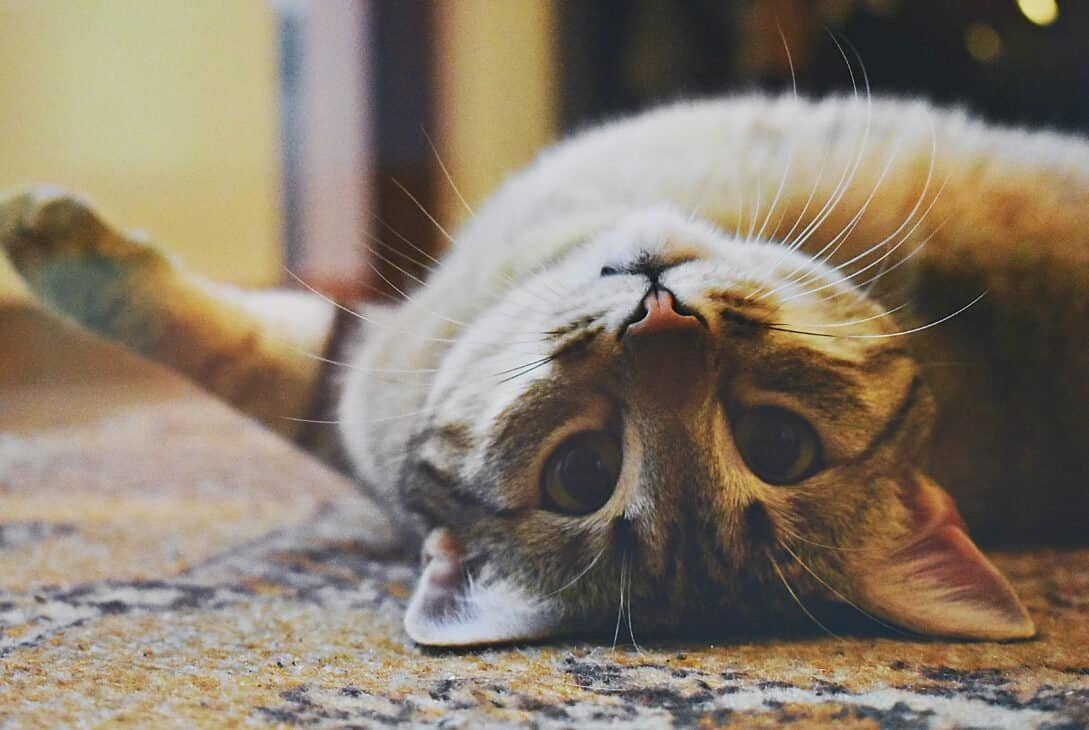Understanding cat pregnancy is crucial for the health of our feline friends. The average cat pregnancy lasts between 63 to 65 days, which is about nine weeks. However, birth timing can vary, with some cats giving birth earlier or later.
If your cat might be pregnant, it’s best to see a vet for confirmation. They offer important advice. This ensures the mother cat and her kittens get the right care.
Key Takeaways:
- The typical duration of cat pregnancy is between 63 to 65 days, or about nine weeks.
- Variations can occur, and some cats may give birth earlier or later.
- Consulting with a veterinarian is crucial for confirming pregnancy and providing appropriate care.
Stages of Feline Pregnancy
Feline pregnancy has five stages. At each stage, both the mother cat and her kittens face big changes and milestones.
Fertilization
The first stage is about fertilization. Here, the fertilized eggs get ready to develop after the sperm and egg join.
Early Stage of Pregnancy
This part lasts about three weeks. The mother cat shows signs like getting heavier, feeling sick in the morning, and having a bigger belly.
Ongoing Pregnancy
After that comes a stage lasting five to six weeks. It’s crucial for the kittens as their organs form and the mother cat gains more weight.
Early Labor Signs
About a week before birth, the mother shows the first signs of labor. These can be not wanting to eat much and temperature changes.
Giving Birth
The last stage is when the kittens are born. The mother cat gets ready, breathes heavily, and licks a lot. Then, everyone welcomes the kittens into the world.
| Stage of Feline Pregnancy | Duration |
|---|---|
| Fertilization | 24-48 hours |
| Early Stage of Pregnancy | Approximately 3 weeks |
| Ongoing Pregnancy | 5-6 weeks |
| Early Labor Signs | Approximately 1 week |
| Giving Birth | Varies, usually within 24 hours |
Determining Pregnancy in Cats
Finding out if your cat is pregnant can be tricky, especially at first. But, there are key signs that can tell you if your cat is expecting. These signs include changes in how your cat looks or acts.
If you see your cat’s nipples changing color or becoming more noticeable, she might be pregnant. This happens about 16-20 days after she mates. It’s called “pinking up.” Remember, other things can cause nipple changes, so watch for other signs too.
As time goes on, your cat’s belly will start to grow. She might also get bigger nipples that are firm to the touch. You’ll see these changes more clearly as the pregnancy goes further.
How your cat acts can also give you clues. A pregnant cat might want more of your time, enjoying extra cuddles. She might also make a cozy spot with bedding for her kittens. These actions can hint that she’s expecting.
Seeing these signs doesn’t always mean your cat is pregnant for sure. It’s wise to get the vet’s opinion. They can check with tests like ultrasounds or X-rays. They can also tell you more about your cat’s pregnancy, like how many kittens she’s having.
Here’s a simple table of pregnancy signs in cats:
| Signs of Cat Pregnancy |
|---|
| Nipple changes (around 16-20 days) |
| Abdominal enlargement |
| Mammary enlargement |
| Increased affection |
| Nesting behavior |
Talking to a vet and keeping an eye out for these signs can let you know if your cat’s having kittens. Finding out early helps you take better care of your cat and her soon-to-arrive kittens.
Duration of Cat Pregnancy
A cat’s pregnancy lasts between 63 to 65 days, which is about nine weeks. During this time, the mother cat changes a lot to help her kittens grow. It’s vital for cat owners to know this timing for good care and preparation for the kittens’ birth.
Cats may give birth a bit early or late, even though nine weeks is the usual time. Hormonal changes, infections, and stress can affect the length of the pregnancy. Every cat’s pregnancy is different, so timing can vary.
Older and younger cats might have shorter pregnancies. The number of kittens born can also affect how long the pregnancy is. Short or long pregnancies based on litter size are common. This shouldn’t worry you, unless other health signs are present.
Cat owners should keep a close eye on their pregnant cats. It’s good to check in with a vet during the pregnancy. This ensures both the mother and kittens stay healthy.
Factors Affecting Cat Pregnancy Duration
Many things can alter how long a cat is pregnant:
- Hormonal imbalances: Changes in hormone levels can change the pregnancy time.
- Infections: Getting sick during pregnancy might make cats give birth early or late.
- Injuries: If a cat is hurt, it could change how long she’s pregnant.
- Stressors: Stress or too much worry might make the pregnancy shorter or longer.
Knowing these factors helps cat owners keep an eye on their pets. If something seems off, talking to a vet is smart.

Comparing Cat Pregnancy Duration and Other Species
| Animal Species | Average Pregnancy Length |
|---|---|
| Cat | 63-65 days |
| Dog | 58-68 days (depending on breed) |
| Human | 280 days (40 weeks) on average |
The table shows cats are pregnant for a shorter time than dogs and humans. This is because each species has its unique needs and growth timeline. Remember, the times listed are averages. There can be differences between individual cats, dogs, or people.
Considerations for Spaying Cats
Responsible cat owners know the benefits of spaying their cats. It stops overbreeding and keeps your pet healthy. Let’s take a closer look at why this is important.
The Benefits of Spaying Cats
Spaying is a surgery that removes a female cat’s ovaries and uterus. It has many good points for both the cat and its owner.
- Elimination of the Risk of Ovarian and Uterine Cancer: It ends the chance of getting two types of cancer. These are common in cats that haven’t been spayed. Taking out the reproductive organs lowers this risk a lot.
- Reduction of Breast Cancer Risk: Spaying early cuts down the chance of breast cancer. This cancer is more likely in females that aren’t spayed.
- Prevention of Pyometra: Pyometra is a bad infection that affects cats that haven’t been spayed. Spaying can save cats from this life-threatening infection. It also avoids costly vet bills.
Importance of Spaying Young Cats
It’s best to spay cats when they are young to avoid problems later. This can stop unwanted litters and health problems. Female cats can get pregnant very young and have several heat cycles in a year.
Spaying them early can help prevent unwanted pregnancies and behavior problems. It stops things like loud meowing and peeing/spraying to mark their territory.
If you spay them by five months, before their first heat, you’re ensuring they’ll be healthy and happy.
The Impact of Spaying on Diabetic Cats
For cats with diabetes, spaying is extra important. Changes during heat cycles can make managing diabetes hard. This can affect their blood sugar levels and their overall health.
Spaying keeps the diabetes in check, making it easier for owners to care for their cats. It lowers the chances of health problems from the diabetes.
| Benefits of Spaying Cats |
|---|
| Elimination of the risk of ovarian and uterine cancer |
| Reduction of breast cancer risk |
| Prevention of pyometra |
Spaying your cat is a smart move that does a lot of good. It prevents many diseases and makes it easier to manage health issues. By spaying, you help control the cat population and lessen the burden on shelters. Talk to your vet about when to spay your cat. This simple step ensures a healthier life for your pet.
What to Expect during Cat Pregnancy
During cat pregnancy, it’s essential to give the mother cat proper care. This ensures her kittens develop healthily. Let’s look at what’s important during this phase.
High-Calorie Diet for Healthy Kittens
The pregnant cat should eat a lot of high-calorie food. This supports her kittens’ growth and health. The diet ensures the kittens get all the right nutrients they need.
Vaccinations Prior to Pregnancy
Before getting pregnant, the cat needs updated vaccinations. This prevents illnesses that could harm her and her kittens. The kittens also get some immunity against these diseases from their mother’s milk.
Continued Parasite Prevention
Parasites are dangerous for pregnant cats and their kittens. Using safe, pregnancy-approved products against parasites is vital. This protects the whole litter from diseases and discomfort caused by fleas and ticks.
Nesting Behaviors and Decreased Appetite
When the birth is near, the mother cat will start nesting. This includes finding a safe place and moving bedding around. Her natural instincts kick in. Her appetite might also drop as the kittens inside her grow larger.
Did You Know? Cats find a quiet spot to give birth by instinct. Making a cozy, secluded area for her birth helps keep her stress-free.
Signs of Labor
Several signs show labor is about to start. The mother cat’s body temperature might go below 100°F (37.8°C). You might see the kittens moving in her belly. And drops of milk can mean she’s getting ready to nurse.
Watching out for these signs and creating a calm space helps with an easy birth. It ensures the kittens start their lives well.
Preparing for Cat Labor and Delivery
As your cat gets closer to her due date, getting ready for labor is key. Make a cozy spot for her so she feels safe. You can use a quiet room and a comfy nesting box with soft bedding. Keep the area warm for the mom and her babies.
Be watchful for when your cat might go into labor. Watch for times when she’s not hungry or is a bit cooler. If you see these signs, labor might start in a day or two.
Signs of Imminent Cat Birth
- Decreased appetite
- Drop in body temperature
- Restlessness or pacing
- Nesting behavior
- Increased vocalization
Labor usually happens in three parts. The first step is contractions for about six hours. The mother may look uneasy. A peaceful space will help her through this.
The next stage is when the kittens are born. Usually, each kitten comes every 10 to 60 minutes. The mother cat might be loud and work hard. You need to keep an eye to make sure all the kittens come out okay.
After the kittens are born, the mom will pass each placenta. She might eat these, which is normal. It helps with nutrients and keeps the place clean.
“Proper preparation and understanding of the labor and delivery process are essential for ensuring the well-being of the mother cat and her kittens. Creating a comfortable environment and monitoring for signs of imminent birth will help you be prepared for this exciting time.”
| Stage | Duration | Description |
|---|---|---|
| Stage 1: Contractions | Approximately 6 hours | The mother cat experiences strong contractions as the kittens move into the birth canal. |
| Stage 2: Delivery of Kittens | 10-60 minutes per kitten | Each kitten is born, and the mother cat cleans them and severs the umbilical cord. |
| Stage 3: Passing of the Placentas | Within 24 hours | The mother cat expels the placentas and consumes them for nutrients. |
Conclusion
It’s key to know how long a cat is pregnant and the steps she goes through. Spotting pregnancy signs lets cat owners give the right care. This keeps the mom cat and her babies healthy and safe.
It’s vital for pregnant cats to see a vet regularly. This checks the mom’s health and catches any issues early. They need to eat well, with a diet high in calories, to help the kittens grow.
Don’t forget vaccinations and preventing parasites. These steps protect the mom and her soon-to-be-born babies from sickness. Considering having the cat spayed after birth helps keep her healthy and stops overpopulation.
To sum up, taking good care of a pregnant cat, from the start to the new kittens’ arrival, makes everything better. It ensures the mom and her babies have a great, comfortable time.
FAQ
How long is a cat pregnant?
What are the stages of feline pregnancy?
How can I determine if my cat is pregnant?
How long does cat pregnancy typically last?
Should I spay my cat?
What should I expect during cat pregnancy?
How should I prepare for cat labor and delivery?
What are the key considerations for caring for a pregnant cat?
Cat birthing process Cat breed-specific pregnancies Cat pregnancy complications Cat pregnancy timeline Cat reproductive cycle Feline gestation period Feline prenatal care Kitten development stages Pregnancy signs in cats
Last modified: April 30, 2024








